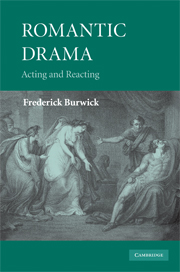Book contents
- Frontmatter
- Contents
- List of illustrations
- Acknowledgments
- Introduction
- 1 Periscopes into the theatre
- 2 Nationalism and national character
- 3 Genre: the realism of fantasy, the fantasy of realism
- 4 Acting: histrionics, and dissimulation
- 5 Transvestites, lovers, monsters: character and sexuality
- 6 Setting: where and elsewhere
- 7 Gothic and anti-Gothic: comedy and horror
- 8 Blue-Beard's castle: mischief and misogyny
- 9 Vampires in kilts
- Notes
- Bibliography
- Index
7 - Gothic and anti-Gothic: comedy and horror
Published online by Cambridge University Press: 04 August 2010
- Frontmatter
- Contents
- List of illustrations
- Acknowledgments
- Introduction
- 1 Periscopes into the theatre
- 2 Nationalism and national character
- 3 Genre: the realism of fantasy, the fantasy of realism
- 4 Acting: histrionics, and dissimulation
- 5 Transvestites, lovers, monsters: character and sexuality
- 6 Setting: where and elsewhere
- 7 Gothic and anti-Gothic: comedy and horror
- 8 Blue-Beard's castle: mischief and misogyny
- 9 Vampires in kilts
- Notes
- Bibliography
- Index
Summary
In the Romantic literature of Britain, the influence of Donatien-Alphonse François, Marquis de Sade (1740–1814) has sustained continued interest since it was first examined in Mario Praz's The Romantic Agony. Both Matthew Gregory Lewis (1775–1818) and George Gordon, Lord Byron (1788–1824), were among those who fell under “the shadow of the divine marquis.” In his scurrilous Gothic romance, The Monk (1796), Lewis described how Ambrosio, a saintly Capuchin monk, is seduced by the beautiful demon Matilda into a life of depravity, committing rape, incest, and murder. In Lewis' Gothic tragedy, The Castle Spectre (1797), Osmond lusts after Evelina, his brother's wife, whom he kills in a struggle with his brother; years later, he holds their daughter imprisoned to force her to submission. Byron, when he departed from England in 1816 amidst the scandal over his relationship with his half-sister Augusta Leigh, left behind in his trunk a bottle of laudanum and a copy of Sade's Justine. According to Leslie Marchand, her discovery of the contents of her husband's trunk convinced Lady Byron that he was seriously deranged. Her discovery is re-enacted in the character of Donna Inez: “She kept a journal, where his faults were noted, / And open'd certain trunks of books and letters.” The obscure but suggestively incestuous sins between Manfred and Astarte in the dark tower demonstrate how Byron, like Lewis, could conjure with Sade's themes.
- Type
- Chapter
- Information
- Romantic DramaActing and Reacting, pp. 170 - 201Publisher: Cambridge University PressPrint publication year: 2009



